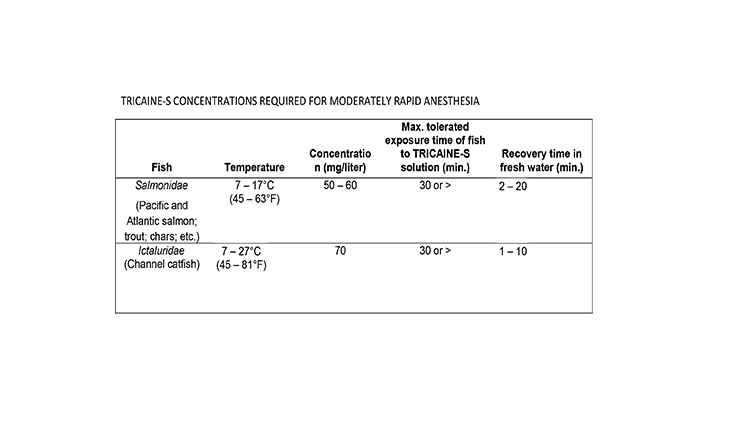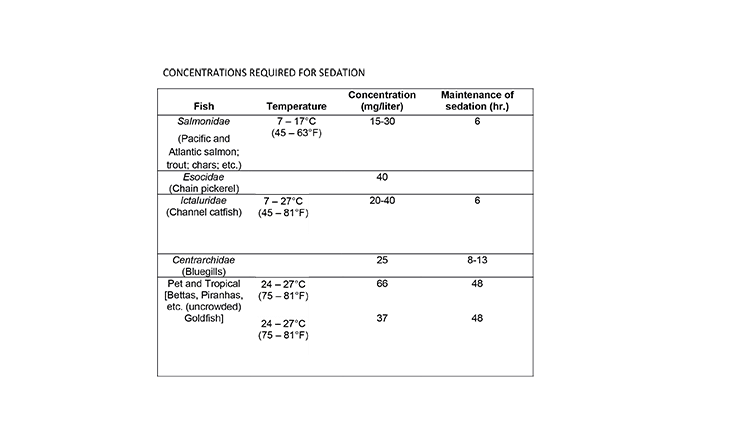When used as directed, Tricaine-S/Syncaine® can be used to safely and effectively anesthetize and immobilize fish.
The amount of Tricaine-S/Syncaine® to use for fish anesthetization is impacted by water temperature and hardness, fish species, and the intended product use.
By adjusting the concentration of product, you can control both sedation and rates of anesthetization to suit your particular application.
Note: When administering anesthetic, it’s essential to conduct preliminary tests on smaller batches of fish to determine the desired rate of anesthesia as well as exposure times.
Factors impacting anesthetic action on fish
The following are a few factors that impact anesthetic action:
Temperature: The action of the anesthetic slows down with cooler temperatures.
Water hardness: The action of the anesthetic slows down with exceptionally soft water (10 mg/liter of calcium carbonate or less).
Fish size: The action of the anesthetic slows down for larger fish.
Fish species: The efficacy of the anesthetic varies by fish species.
When determining how much Tricaine-S/Syncaine® to use, all of the above factors must be taken into consideration.
Rapid Anesthesia, Moderately Rapid Anesthesia, or Sedation?
To determine how much Tricaine-S/Syncaine® to use, you’ll also need to know whether you require rapid anesthesia, moderately rapid anesthesia, or sedation.
Rapid anesthesia has an induction time of less than 2-5 minutes. It is used in marking, measuring, spawning, and some surgical procedures.
Moderately rapid anesthesia has an induction time of less than 15-20 minutes. It is used in marking, spawning, and surgical procedures where fish require longer exposure time.
Sedation has an induction time of 15 minutes or less. It is used specifically for fish transport.
Approved Tricaine-S/Syncaine® Concentrations
The following concentrations are approved by the FDA for anesthetization of fish based on factors including species, temperature, exposure time, and recovery time.



IMPORTANT: Since, in many cases, relatively rapid rates of anesthesia can be achieved only by exceeding the lethal concentration of TRICAINE-S, it is necessary to return anesthetized fish to fresh water before they are overexposed. Excessive exposures are avoided by observing the following sensory and motor responses of the fish which characterize progressively deeper levels of anesthesia:
Sedation – Decreased reactivity to visual and vibrational stimuli; opercular activity reduced.
Total loss of equilibrium – Fish turns over; locomotion ceases; fish swims or extends fins in response to pressure on caudal fin or peduncle.
Total loss of reflex – No response to pressure on caudal fin or peduncle; opercular rate slow and erratic.
Medullary collapse – Opercular activity ceases.
Laboratory and field investigations have shown that the action of TRICAINE-S is readily
reversed when the fish are transferred to fresh water before opercular activity ceases.
Additional exposure following medullary collapse may result in mortality. A rough estimate
of the safe total exposure can be made by multiplying the time required for anesthesia by a
factor of 2 or 3.
Once you’ve determined the concentration of anesthetic in mg/L, you can refer to the dosage chart to calculate how much Tricaine-S to use based on container size: https://syndel.com/wp-content/uploads/2019/01/new-tricaine_s_dosage_chart..pdf
You can also use the concentration calculator below.
ADDITIONAL RESOURCES FOR TRICAINE-S/SYNCAINE® DOSAGE, CONCENTRATION, AND USAGE
For additional information on the use of Tricaine-S for fish anesthetization, refer to the following resources:
Tricaine-S/Syncaine® Directions for Use
